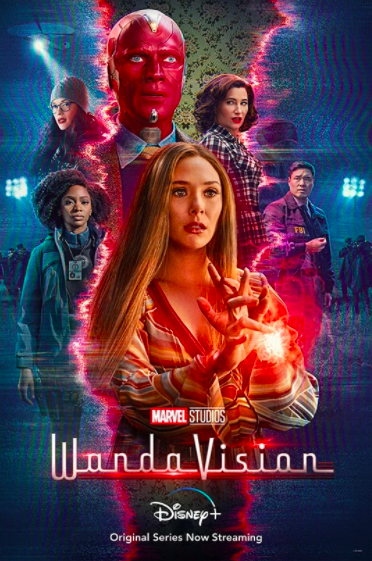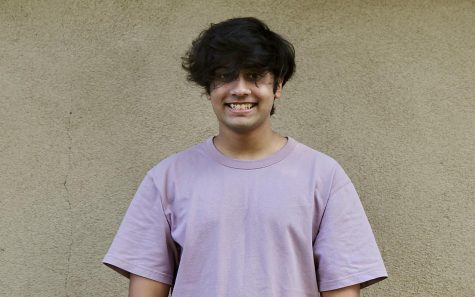“WandaVision” magics its way into our hearts

While “WandaVision” is a confusing show at times, its masterfully placed easter eggs — and their greater implications for the Marvel Cinematic Universe (MCU) — makes the show a must-watch for both avid fans and casual watchers.
March 17, 2021
Nearly two months after its pilot, producer Kevin Feige’s nine-episode spectacular has come to a close. “WandaVision,” a cryptic sitcom series where nothing is as it seems, has rejuvenated the Marvel fanbase. Every Friday morning, viewers took to social media, ready to spin theories about the latest episode and collectively digest its implications. While “WandaVision” is a confusing show at times, its masterfully placed easter eggs — and their greater implications for the Marvel Cinematic Universe (MCU) — makes the show a must-watch for both avid fans and casual watchers.
Taking place three weeks after the events of “Avengers: Endgame,” “WandaVision” is, at its core, a deep dive through Wanda Maximoff’s psyche. Riddled with grief after losing her robotic lover Vision, she constructs a new reality for herself, in which she and Vision can live out the happy ending that they never had. The small town of Westview, New Jersey, becomes Wanda’s new home, as she and a newly-formed Vision navigate Wanda’s mysterious sitcom bubble world they have created for themselves. Outside the bubble, Director Tyler Haywood, head of the Sentient Weapon Observation and Response Division (SWORD), begins to investigate the cause of a disturbance that he dubs “the Westview Anomaly.”
While the scenes outside Westview are important, it is within Westview that “WandaVision” truly starts to shines. From the first episode’s signature jingle, “WandaVision” completely immerses its viewers inside the Westview Anomaly. As Vision and Wanda attempt to piece together why they’re in Westview, the viewer is left to explore the streets of the imaginary town, trying to come up with their own explanations. The intriguing nature of the show captivates fans, leaving them craving more after each episode ends.
This immersive experience, however, would not have been possible if not for the show’s magnificent special effects and cinematography. The effects look especially realistic, rivaling even the best computer-generated imagery (CGI) the rest of the MCU has to offer. Director Matt Shakman makes full use of this world-bending CGI in the show’s numerous fight scenes, all of which add to the stark realism of the show.
Shakman’s incredible talent is only further highlighted by the show’s format. Each “episode” of “WandaVision” shot inside Westview is based off a sitcom from a different time period; add to that the jumps between the interior and exterior of the Westview Anomaly, and the filming of each space becomes much more complicated. Shakman, however, masterfully weaves his camera seamlessly between the sitcom inside the bubble and the military response happening outside. Shakman’s aptitude for integrating the two worlds is a large reason the show has a wide appeal.
Although the show’s format is unique and creative, it sometimes prevents the plot from moving forward. Episode 1 in particular leaves the viewers confused and disoriented, as they’re left to wonder why Wanda and Vision are starring in a 1950s sitcom. Viewers aren’t spoon-fed the plot right away: they have to piece together the mystery of the Westview Anomaly themselves. While most viewers have enjoyed this new, experimental format, some viewers will find the first three episodes off-putting. Watching episodes 1 and 2 in the same sitting — as the producers likely intended, given that Disney+ released the episodes at the same time — alleviates some of the confusion surrounding the earlier episodes and makes for a less disjointed viewing experience.
This isn’t to say the episodes focused on the sitcoms aren’t entertaining, though. In another testament to Shakman’s prowess as a director, each “WandaVision” episode inside the bubble does a fantastic job of retaining the feel of its source material. Drawing inspiration from sitcom classics such as “The Dick Van Dyke Show,” “The Brady Bunch,” “Family Ties” and “Modern Family,” the show is able to transitions smoothly between filming styles thanks to not only Shakman, but also the riveting performance of Elizabeth Olsen, who plays Wanda in the series.
Throughout the show, she flits effortlessly between time periods, most notably doing her best Claire Dunphy impression in Episode 7. This ability is not even the most impressive part of her performance, though. The way in which Olsen so poignantly captures Wanda’s downward spiral is mesmerizing. By the end of each episode, Olsen’s heart-wrenching performance leaves viewers with an existential melancholy that grows deeper with each installment.
The supporting actors also come through with strong performances; Paul Bettany’s recast as Vision continues to demonstrate why he’s perfect for the role. His on-screen chemistry with Olsen is off-the-charts, and is felt even through the show’s different time periods. Kathryn Hahn strings together a strong performance as the pair’s nosy neighbor, Agnes. The rest of the cast brings their respective characters to life as well.
In large part due to the charismatic performances of the cast, “WandaVision” has been able to introduce a staggering number of new characters into the show while staying true to the nature of each character’s personality and developing their backstory thoroughly. Outside the bubble, Monica Rambeau fights Haywood’s devious schemes while attempting to reach Wanda inside the bubble. Her character arc climaxes during her final attempt to reach Wanda, and ties nicely to her introduction as the spunky young girl in “Captain Marvel.” Supporting characters like Jimmy Woo and Darcy Lewis add to the show by being likeable and humorous while driving the plot forward. Woo in particular has become a fan favorite, with rumors of an X-Files type Disney+ show starring Randall Park as Woo to be in the making.
The season’s finale, however, did not quite live up to the hype it had built up over its two- month run. Fan speculation leading up to the finale ran rampant: everyone was theorizing about what the finale could bring. “WandaVision” thus far had been extraordinary. As such, it deserved an extraordinary, universe-bending finale, not a generic conclusion to hastily tie together the show’s loose ends.
While the finale disappointed some fans, “WandaVision” still does a good job of tying the show into the rest of the MCU. The first end-credit scene showcases Wanda at the height of her abilities, and does a great job of setting up the upcoming “Doctor Strange 2: Multiverse of Madness.” Rambeau also gets an end-credits scene that is sure to tie into “Captain Marvel 2.” It’s amazing that Marvel has been able to move on from the Infinity Saga and give fans fresh, interesting plotlines to look forward to.
Although some parts of the show come off as unnecessary and heavy-handed, “WandaVision” does a great job of immersing its viewers in the world of Westview. This show not only adds to the MCU, but expands its possibilities, making this a must watch for any Marvel fan.


































































